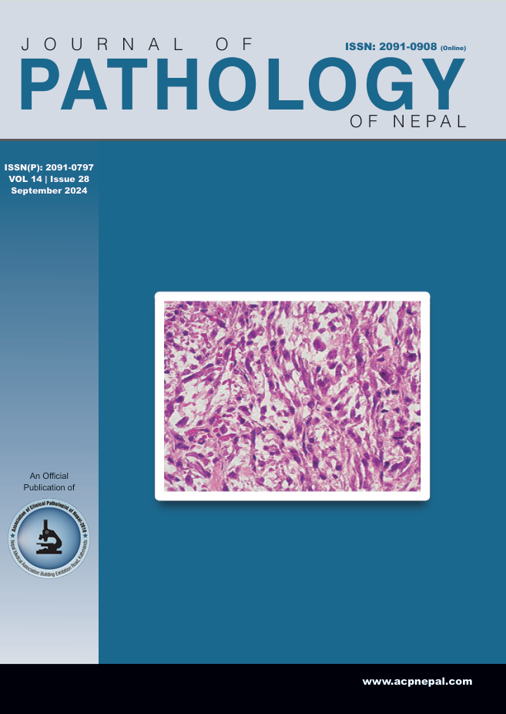Clinicopathological correlation and expression of PD-L1 in cervical carcinoma: An immunohistochemical study
DOI:
https://doi.org/10.3126/jpn.v14i2.65788Keywords:
Cervical carcinoma, Immunohistochemistry, Immunotherapy, PDL-1Abstract
Background: Cervical cancer is the fourth most common cancer in women globally and the second leading cause of cancer deaths in India. Risk factors include HPV infection, smoking, long-term oral contraceptive use, early pregnancy, nulliparity, and multiple sexual partners. Programmed cell death-1/programmed cell death-ligand 1 (PD-1/PD-L1) inhibitors may improve outcomes in recurrent, persistent, or metastatic cervical cancer. This study aimed to determine the various histological types of cervical carcinoma, determine PD-L1 expression, correlate it with PDL1-positive TILs, and provide insight into clinicopathological parameters such as age, stage, etc.
Materials and methods: This prospective cross-sectional study (July 2022–June 2023) analyzed 50 histopathologically confirmed cervical carcinoma cases at a tertiary care institute in India. The tumors were classified, graded, and subjected to PD-L1 immunohistochemistry.
Results: Squamous cell carcinoma (SCC) was the most common type, followed by adenocarcinoma. PD-L1 positivity was observed in 36% of cases, predominantly in SCC (39.1%). Expression increased with tumor grade and stage (p = 0.046), while tumor-infiltrating lymphocytes decreased in poorly differentiated tumors, indicating reduced immune response. The study highlights the significance of PD-L1 expression in cervical carcinoma and suggests routine immunohistochemical testing to identify patients eligible for targeted therapy, facilitating personalized treatment approaches.
Conclusions: The study highlights the significance of PD-L1 expression in cervical carcinoma and suggests routine immunohistochemical testing to identify patients eligible for targeted therapy, facilitating personalized treatment approaches.
Downloads
Downloads
Published
How to Cite
Issue
Section
License
Copyright (c) 2024 The Author(s)

This work is licensed under a Creative Commons Attribution 4.0 International License.
This license enables reusers to distribute, remix, adapt, and build upon the material in any medium or format, so long as attribution is given to the creator. The license allows for commercial use.




